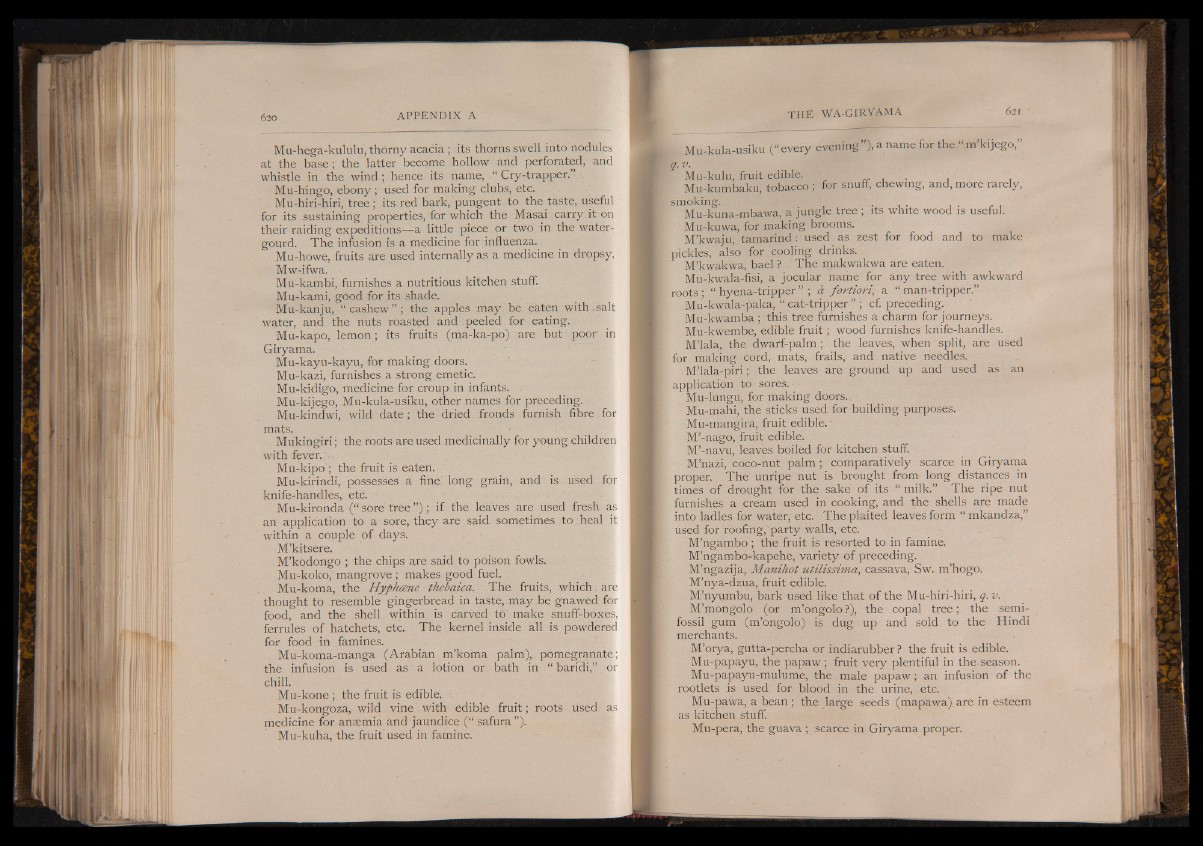
Mu-hega-kululu, thorny acacia ; its thorns swell into nodules
at the base; the latter become hollow and perforated, and
whistle in the wind; hence its name, “ Cry-trapper.”
Mu-hingo, ebony ; used for making clubs, etc.
Mu-hiri-hiri, tree; its red bark, pungent to the taste, useful
for its sustaining properties, for which the Masai carry it on
their raiding expeditions— a little piece or two in the water-
gourd. The infusion is a medicine for influenza.^
Mu-howe, fruits are used internally as a medicine in dropsy,
Mw-ifwa.
Mu-kambi, furnishes a nutritious kitchen stuff.
Mu-kami, good for its shade.
Mu-kanju, “ cashew” ; the apples may be eaten with salt
water, and the nuts roasted and 5 peeled for eating.
Mu-kapo, lemon; its fruits (ma-ka-po) are but poor in
Giryama.
Mu-kayu-kayu, for making doors.
Mu-kazi, furnishes a strong emetic.
Mu-kidigo, medicine for croup in infants.
Mu-kijego, Mu-kula-usiku, other names for preceding.
Mu-kindwi, wild date; the dried fronds furnish fibre for
mats.
Mukingiri; the roots are used medicinally for young children
with fever.
Mu-kipo; the fruit is eaten.
Mu-kirindi, possesses a fine long grain, and is used for
knife-handles, etc.
Mu-kironda (“ sore tree”); if the leaves are used fresh as
an application to a sore, they are said sometimes to heal it
within a couple of days.
M’kitsere.
M’kodongo ; the chips are said to poison fowls.
Mu-koko, mangrove ; makes good fuel.
Mu-koma, the Hyphcme thebaica. The fruits, which , are
thought to resemble gingerbread in taste, may be gnawed for
food, and the shell within is carved to'make snuff-boxes,
ferrules of hatchets, etc. The kernel inside all is powdered
for food in famines.
Mu-koma-manga (Arabian m’koma palm), pomegranate;
the infusion is used as a lotion or bath in “ baridi,” or
chill.
Mu-kone ; the fruit is edible.
Mu-kongoza, wild vine with edible fruit; roots used .as
medicine for anaemia and jaundice (“ safura”).
Mu-kuha, the fruit used in famine.
Mu-kula-usiku (“ every evening”), a name for the “ m’kijego,”
q. v.M
u-kulu, fruit edible. Br , ' • 1 1
M u -k um b a k u , to b a c c o ; fo r snu ff, c h ew in g , an d , m o re ra re ly ,
smoking..
M u -k u n a -m b aw a , a ju n g le t r e e ; its w h ite w o o d is use fu l.
Mu-kuwa, for making brooms.
M’kwaju, tamarind: used as zest for food and to make
pickles, also for cooling drinks.
M’kwakwa, bael ? The njakwakwa are eaten.
Mu-kwala-fisi, a jocular name for any tree with awkward
roots ; “ hyena-tripper ” ; a fortiori, a “ man-tripper.”
Mu-kwala-paka, “ cat-tripper ” ; cf. preceding.
Mu-kwamba; this tree furnishes a charm for journeys.
Mu-kwembe, edible fruit; wood furnishes knife-handles.
M’lala, the dwarf-palm ; the leaves, when split, are used
for making cord, mats, frails, and native needles.
M’lala-piri; the leaves are ground up and used as an
application to sores. ■
Mu-lungu, for making doors.,
Mu-mahi, the sticks used for building purposes.
Mu-mangira, fruit edible.'
M’-nago, fruit edible.
M’-navu, leaves boiled for kitchen stuff.
M’nazi, coco-nut palm; comparatively scarce in Giryama
proper. The unripe nut is brought from long distances in
times of drought for the sake of its “ milk.” The ripe nut
furnishes a cream used in cooking, and the shells are made
into ladles for water, etc. The plaited leaves form “ mkandza,”
used for roofing,'party walls, etc.
M’ngambo ; the fruit is resorted to in famine.
M’ngambo-kapehe, variety of preceding.
M’ngazija, Manihot utilissima, cassava, Sw. m’hogo.
M’nya-dzua, fruit edible.
M’nyumbu, bark used like that of the Mu-hiri-hiri, q. v.
M’mongolo (or m’ongolo ?), the copal tree; the semifossil
gum (m’ongolo.) is dug up and sold to the Hindi
merchants.
M’orya, gutta-percha or indiarubber? the fruit is edible.
Mu-papayu, the papaw ; fruit very plentiful in the season.
Mu-papayu-mulume, the male papaw; an infusion of the
rootlets is used for blood in the urine, etc.
Mu-pawa, a bean ; the .large seeds (mapawa). are in esteem
as kitchen stuff.
Mu-pera, the guava ; scarce in Giryama proper.